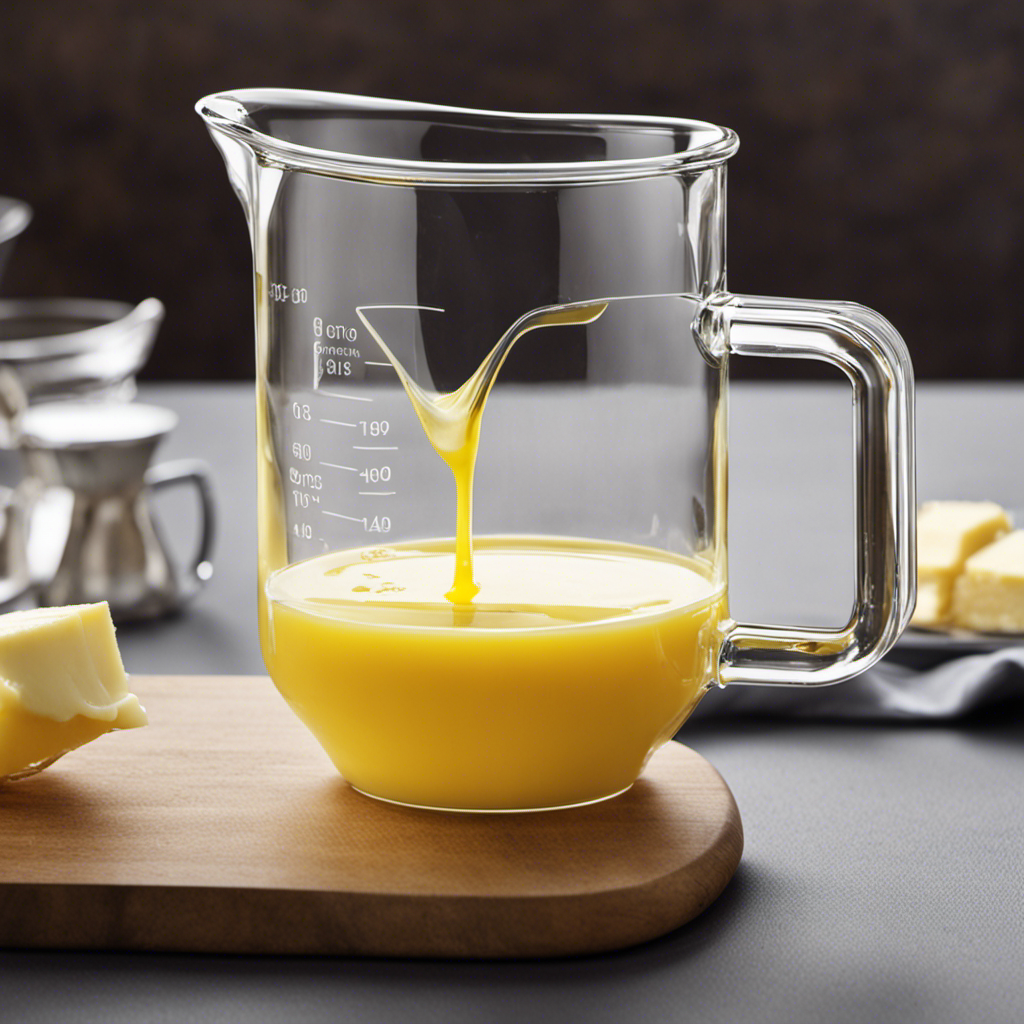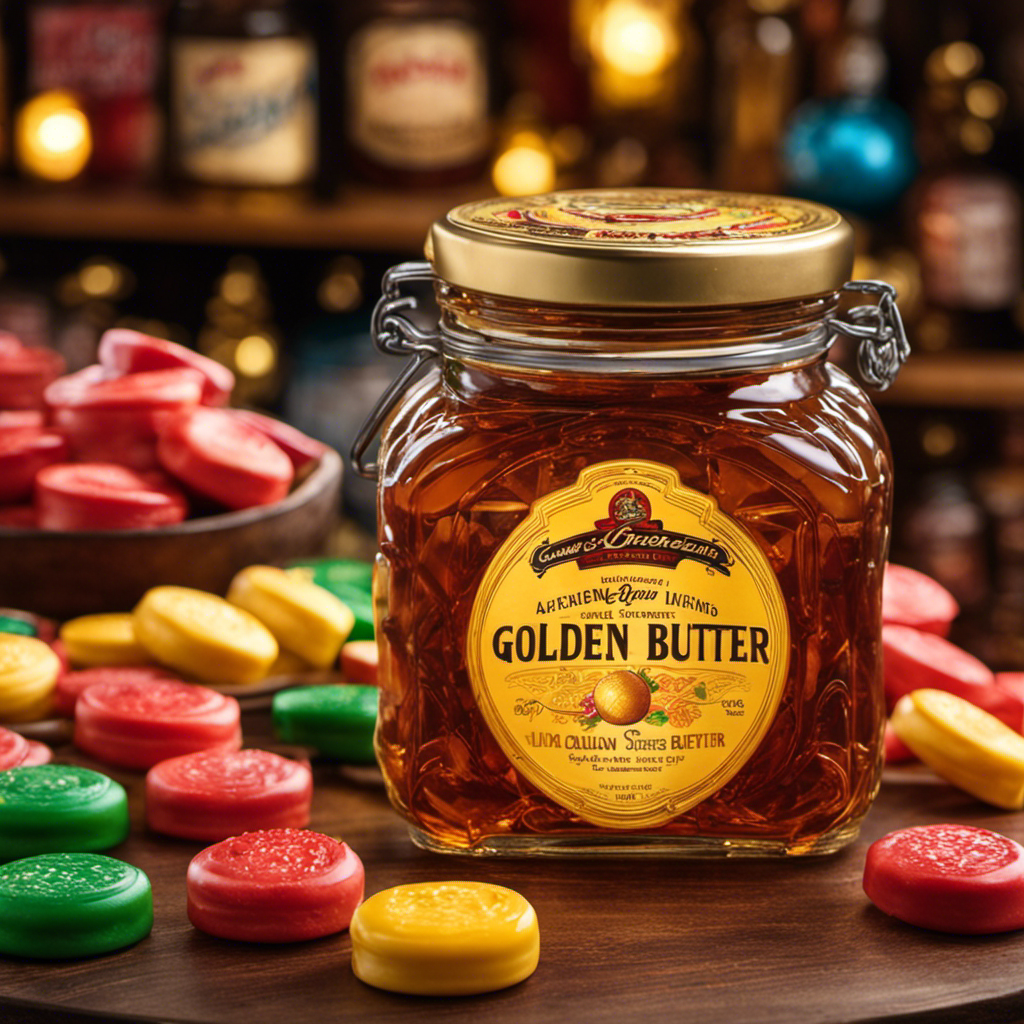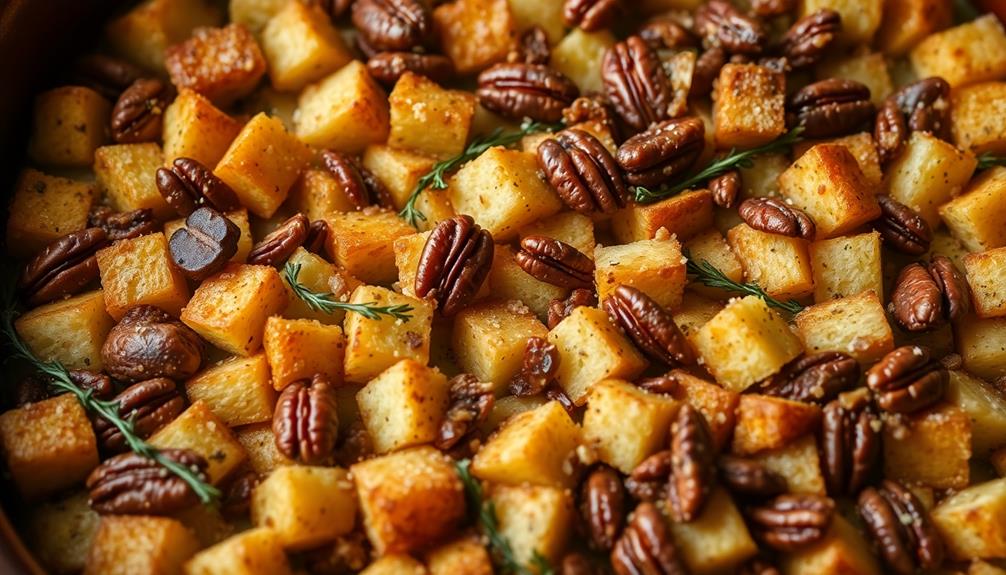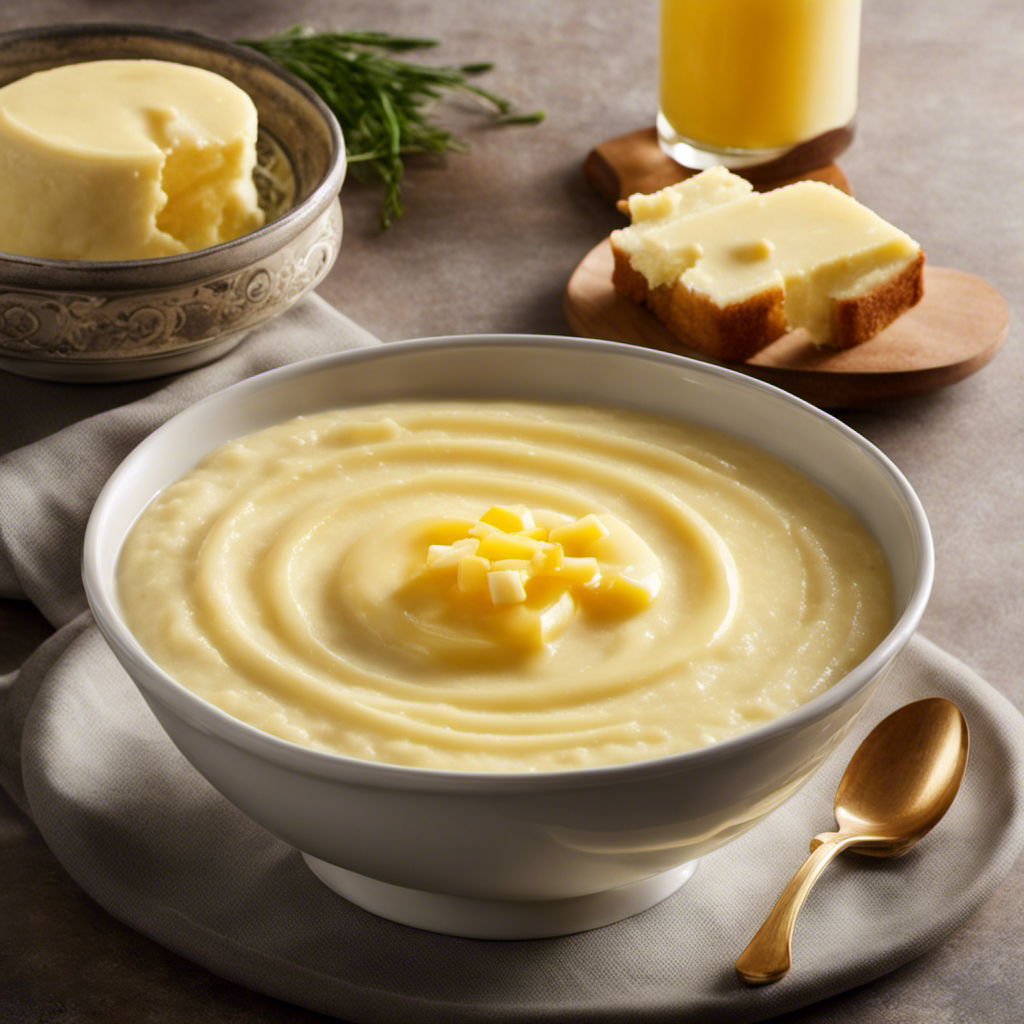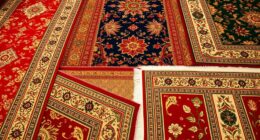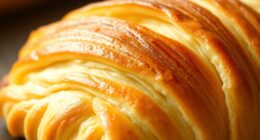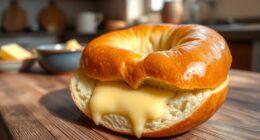As someone who cooks at home, I recognize that comprehending measurements is just as vital as using the correct ingredients. With butter, being aware of the exact amount needed can be the difference between success and failure in a recipe.
So, let’s dive into the world of butter measurements and answer the question that’s been on your mind: how many tablespoons are in half a cup of butter?
Get ready to become a pro at converting and measuring butter with these handy tips and tricks.
Key Takeaways
- Accurate measurements of butter are crucial in baking and cooking.
- 1 stick of butter is equivalent to 8 tablespoons or 1/2 cup.
- To convert tablespoons to cups, divide by 16. To convert cups to tablespoons, multiply by 16.
- Different tools like kitchen scales, measuring spoons, and conversion tables can help in measuring butter accurately.
The Importance of Knowing Measurements
Knowing the importance of measurements can help me accurately follow recipes and avoid any potential cooking mishaps. Precise measurements are crucial in cooking because they ensure that the ingredients are in the correct proportions, resulting in a successful dish.
When it comes to measuring ingredients accurately, there are a few tips that can make a big difference. First, always use the appropriate measuring tool for the ingredient you are measuring. For example, use liquid measuring cups for liquids and dry measuring cups for dry ingredients. Additionally, make sure to level off the ingredients in the measuring cup to ensure accuracy.
Understanding Butter Measurements
When it comes to baking and cooking, accuracy in measurements is crucial, especially when it comes to butter.
In this discussion, I will be addressing two important aspects related to butter measurements: butter conversion equivalents and measuring butter accurately.
Understanding these key points will not only help you follow recipes more effectively but also ensure that your dishes turn out perfectly every time.
Butter Conversion Equivalents
To convert butter measurements, it’s important to have accurate measurements when baking or cooking with butter to ensure the best results. Here are some tips to help you with butter measurement equivalents and improve your conversion accuracy:
- Use a kitchen scale: Weighing your butter in grams or ounces can provide the most precise measurements.
- Use a liquid measuring cup: When measuring melted butter, use a liquid measuring cup rather than a dry measuring cup for accuracy.
- Be aware of different butter packaging: Butter can come in various forms such as sticks, blocks, or tubs, so make sure to check the packaging for conversion ratios.
- Don’t forget about unsalted butter: If a recipe calls for unsalted butter and you only have salted butter, reduce the amount of added salt in the recipe to maintain the right balance.
- Practice and keep a conversion chart: The more you convert butter measurements, the more comfortable you’ll become. Consider keeping a conversion chart handy for easy reference.
Measuring Butter Accurately
Measuring butter accurately is essential for achieving the best results in your baking and cooking recipes. Common butter measurements include tablespoons, cups, and grams. To help you measure butter accurately, refer to the table below:
| Measurement | Butter Equivalent |
|---|---|
| 1 tablespoon | 1/8 cup |
| 1/4 cup | 4 tablespoons |
| 1/2 cup | 8 tablespoons |
Converting Cups to Tablespoons
When it comes to measuring butter, understanding the conversion between tablespoons and cups is essential. Knowing how many tablespoons are in a cup can make a significant difference in your cooking and baking.
In this discussion, we will explore the butter measurement conversions, specifically focusing on the comparison between tablespoons and cups.
Butter Measurement Conversions
There are 8 tablespoons in half a cup of butter. Converting butter measurements can be a bit tricky, but with the right knowledge, it can be a breeze. Here are some helpful tips to keep in mind:
-
1 stick of butter is equal to 8 tablespoons or 1/2 cup.
-
1/2 cup of butter is equivalent to 1 stick or 8 tablespoons.
-
If a recipe calls for 1 cup of butter, you will need 2 sticks or 16 tablespoons.
-
To convert tablespoons to cups, divide the number of tablespoons by 16.
-
To convert cups to tablespoons, multiply the number of cups by 16.
Knowing these butter measurement equivalents will make it easier for you to follow recipes and create delicious dishes. So the next time you’re in the kitchen, you’ll have the confidence to convert butter measurements like a pro!
Tablespoons Vs. Cups
If you’re unsure about the difference between tablespoons and cups, it’s important to remember that tablespoons are smaller than cups and can hold less liquid. Tablespoons are commonly used for smaller measurements, such as adding spices or condiments to a recipe. Cups, on the other hand, are used for larger quantities, like measuring flour or liquids. To convert tablespoons to cups, you can use a simple conversion factor of 16 tablespoons per cup. Here is a helpful table to visualize the difference between tablespoons and cups:
| Tablespoons | Fluid Ounces | Cups |
|---|---|---|
| 1 | 0.5 | 1/16 |
| 2 | 1 | 1/8 |
| 3 | 1.5 | 3/16 |
| 4 | 2 | 1/4 |
Understanding the difference between tablespoons and cups is essential for accurate measurements in cooking and baking. Now, let’s move on to the basics of measuring butter.
The Basics of Measuring Butter
To measure butter, you’ll need to know the basics, like how many tablespoons are in half a cup. Here are some tips for measuring butter without a scale and converting butter measurements for baking:
-
Softened butter: When a recipe calls for softened butter, it means the butter should be at room temperature. This makes it easier to cream with other ingredients.
-
Measuring with tablespoons: If you don’t have a scale, you can use tablespoons to measure butter. There are 8 tablespoons in half a cup.
-
Converting to grams: If you need to convert butter measurements for a recipe, 1 tablespoon of butter is equal to about 14 grams.
-
Measuring cold butter: If the recipe requires cold butter, you can use a grater to measure it. Grate the butter until you have the desired amount.
-
Butter substitutes: If you’re out of butter, you can use margarine or shortening as a substitute, but keep in mind that it may affect the taste and texture of the final dish.
How Many Tablespoons in a Stick of Butter
You’ll be pleased to know that a stick of butter is equivalent to 8 tablespoons.
This information is particularly useful when you’re trying to figure out how much butter to use in a recipe or when converting butter measurements for baking.
Many recipes call for butter to be measured in tablespoons, so knowing this conversion can save you from having to guess or make adjustments.
For example, if a recipe calls for 1/2 cup of butter, you can easily convert that to 8 tablespoons.
This precision ensures that your baked goods turn out just right.
How Many Tablespoons in a Half Cup of Butter
When measuring a half cup of butter, make sure you know the equivalent amount in tablespoons. Accurate measurements are crucial in cooking and baking, as they can greatly affect the outcome of your recipe. Converting butter measurements can be a bit tricky, but once you understand the ratios, it becomes much easier.
Here are some key points to keep in mind:
- 1 stick of butter is equal to 8 tablespoons.
- 1 cup of butter is equal to 16 tablespoons.
- Therefore, half a cup of butter is equal to 8 tablespoons.
By knowing these conversions, you can confidently measure half a cup of butter in tablespoons. It is important to be precise in your measurements, as even a small difference can alter the texture and taste of your final dish.
Now that we have covered measuring half a cup of butter, let’s move on to the next section about using tablespoons for accurate measurements.
Measuring Half a Cup of Butter in Tablespoons
Measuring a half cup of butter in tablespoons is essential for precise cooking and baking. When it comes to measuring butter equivalents, understanding the conversion from cups to tablespoons is key.
One cup of butter is equal to 16 tablespoons. Therefore, half a cup of butter would be equivalent to 8 tablespoons. This knowledge is crucial for following recipes accurately and achieving the desired taste and texture in your dishes.
Whether you’re making cookies, cakes, or savory dishes, knowing how to convert butter measurements is a fundamental skill in the kitchen. So, next time you come across a recipe that calls for half a cup of butter, remember that it’s equivalent to 8 tablespoons.
Happy cooking!
Handy Kitchen Conversion Tips
When it comes to cooking and baking, accurate measurements are key to ensuring successful results. In this discussion, I will be addressing three important aspects of kitchen measurements:
-
Butter measurement equivalents: Understanding how to measure butter in different units, such as tablespoons or grams, can be useful in various recipes.
-
Conversion accuracy tips: I will provide tips on ensuring accurate conversions between different units of measurement.
-
Simplifying kitchen measurements: I will share techniques to simplify the process of measuring ingredients in the kitchen.
Accurate measurements are crucial in cooking and baking to achieve desired outcomes. In this discussion, I will cover three important aspects of kitchen measurements: butter measurement equivalents, conversion accuracy tips, and simplifying kitchen measurements. Knowing how to measure butter in different units, such as tablespoons or grams, is essential for various recipes. Additionally, I will provide tips on ensuring accurate conversions between different units of measurement. Lastly, I will share techniques to simplify the process of measuring ingredients in the kitchen.
Butter Measurement Equivalents
There are 8 tablespoons in half a cup of butter. When it comes to cooking or baking, it’s important to have accurate measurements. Knowing the butter measurement equivalents can save you time and ensure successful results in the kitchen.
Here are some handy butter conversion equivalents to keep in mind:
- 1 stick of butter: equivalent to 1/2 cup or 8 tablespoons
- 1/4 cup of butter: equivalent to 4 tablespoons or 1/2 stick
- 1/2 pound of butter: equivalent to 2 cups or 4 sticks
- 1 pound of butter: equivalent to 4 cups or 8 sticks
- 1 ounce of butter: equivalent to 2 tablespoons or 1/4 stick
Having these butter measurement equivalents at your fingertips will make it easier to follow recipes and ensure that your dishes turn out just right.
Conversion Accuracy Tips
To ensure accurate conversions in the kitchen, you’ll want to be mindful of the weight of the butter you’re using. When it comes to baking and cooking, precise measurements are crucial for achieving the desired results.
Here are some handy kitchen conversion tips to help you maintain conversion accuracy.
First, always use a kitchen scale to measure the weight of the butter instead of relying solely on volume measurements. This will ensure that you have the exact amount needed for your recipe.
Additionally, it’s important to know the conversion ratios for different units of measurement. For example, 1 cup of butter is equal to 16 tablespoons or 226 grams.
By being mindful of these conversion accuracy tips, you can confidently create delicious dishes in the kitchen.
Now, let’s explore some techniques for simplifying kitchen measurements.
Simplifying Kitchen Measurements
When it comes to cooking, precision is key. Simplifying kitchen measurements can make a world of difference in the outcome of your dishes. Here are some reasons why precision is important in cooking:
-
Accurate measurements ensure consistent results: When you follow a recipe closely and measure ingredients precisely, you can expect the same delicious outcome every time.
-
Balancing flavors: Certain ingredients, like salt or spices, can easily overpower a dish if not measured correctly. Precise measurements help you achieve the perfect balance of flavors.
-
Baking success: Baking is a science that requires precise measurements. Too much or too little of an ingredient can result in a cake that doesn’t rise or cookies that spread too much.
-
Recipe conversions: When scaling recipes up or down, precise measurements are crucial for maintaining the correct ratios of ingredients.
-
Nutritional information: Accurate measurements allow you to calculate the nutritional content of your dishes, helping you make informed choices about your diet.
Converting Butter Measurements for Recipes
If you’re wondering about converting butter measurements for recipes, you’ll need to know that there are 8 tablespoons in half a cup of butter.
Precise measurements are crucial in baking and cooking, as they can greatly affect the outcome of your dish. When it comes to butter, it is important to measure it accurately to ensure the right balance of fat and moisture in your recipes.
One common mistake is using the wrong type of measurement. Some people may mistakenly use a liquid measuring cup instead of a dry measuring cup, resulting in an incorrect amount of butter.
Another common mistake is not properly packing the butter into the measuring cup, which can lead to inaccurate measurements.
To avoid these errors, always use the appropriate measuring tools and follow the recipe instructions carefully.
Common Butter Measurements in Tablespoons
Knowing the conversions for common butter measurements in tablespoons can help you accurately measure and use the right amount in your recipes. Here are some common butter measurements in tablespoons:
- 1 tablespoon of butter is equal to 0.5 ounces or 14 grams.
- 4 tablespoons of butter is equal to 1/4 cup or 2 ounces.
- 8 tablespoons of butter is equal to 1/2 cup or 4 ounces.
- 16 tablespoons of butter is equal to 1 cup or 8 ounces.
- 32 tablespoons of butter is equal to 2 cups or 16 ounces.
Converting butter measurements can be a bit tricky, especially if you’re working with a recipe that uses different units. However, having a clear understanding of these common conversions will make your cooking experience much smoother. By knowing how many tablespoons are in a specific amount of butter, you can easily adjust your recipe according to your needs.
Useful Tools for Measuring Butter Accurately
To accurately measure butter, you can use useful tools such as a kitchen scale or measuring spoons. These tools provide precise measurements, ensuring your recipes turn out just right. When it comes to measuring butter, there are different units of measurement you might encounter, including tablespoons, cups, and grams. Converting between these measurements can be confusing, but with the right tools and knowledge, it becomes a breeze. Here’s a handy table to help you convert butter measurements:
| Butter Measurement | Equivalent in Tablespoons | Equivalent in Cups | Equivalent in Grams |
|---|---|---|---|
| 1 tablespoon | 1 | 1/16 | 14.2 |
| 1/4 cup | 4 | 1/4 | 56.7 |
| 1/2 cup | 8 | 1/2 | 113.4 |
| 1 cup | 16 | 1 | 226.8 |
| 1 pound | 32 | 2 | 453.6 |
With this table, you can easily convert butter measurements and ensure your recipes come out perfectly every time. Happy baking!
Frequently Asked Questions
How Do I Measure Butter Accurately Without Using Measuring Spoons or Cups?
I find it helpful to measure butter accurately without spoons or cups by using the markings on the butter wrapper. Each tablespoon is usually indicated, allowing for easy and precise measurements. This alternative butter measurement method is convenient and reliable.
Can I Substitute Margarine for Butter in Recipes That Call for Half a Cup of Butter?
When substituting margarine for butter, it’s important to consider taste and health benefits. While butter adds richness and flavor, margarine offers a lower saturated fat content. Experiment with both to find your preference.
Is There a Difference in Measurement Between Salted and Unsalted Butter When Converting Cups to Tablespoons?
There is a difference in accuracy between salted and unsalted butter when converting cups to tablespoons. Using salted butter may affect the taste of the recipe, so it’s important to follow the measurement accurately.
Can I Use a Digital Scale to Measure Half a Cup of Butter Instead of Using Tablespoons?
Yes, you can use a digital scale as an alternative measurement to measure half a cup of butter. It’s a precise and convenient method that eliminates the need for tablespoons.
Are There Any Tips for Easily Softening Butter to Measure Half a Cup Accurately?
To accurately measure half a cup of butter without measuring spoons or cups, I recommend softening the butter before measuring. Some tips for quickly softening butter include leaving it at room temperature or using a microwave.
Conclusion
In conclusion, knowing the precise measurements in cooking is crucial for achieving the perfect results.
Understanding the measurements of butter, such as how many tablespoons are in half a cup, can make a significant difference in your culinary creations.
By using handy kitchen conversion tips and common butter measurements, you can accurately measure butter for any recipe.
So, the next time you’re in the kitchen, ask yourself, ‘Am I measuring my butter accurately?’ and watch your dishes reach new levels of deliciousness.
